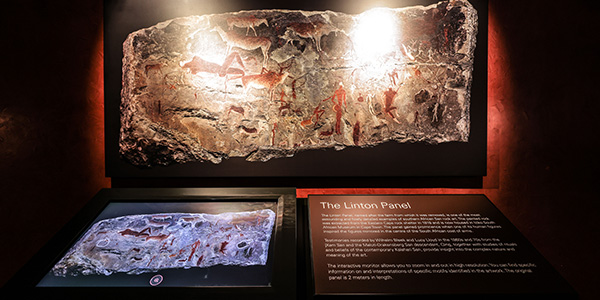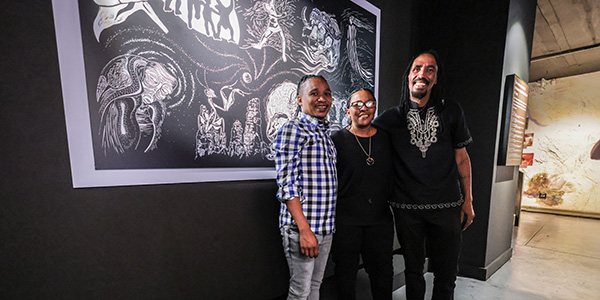The ancient San painting featured in SA’s coat of arms
- Wits University
The exhibition titled ǃke e꞉ ǀxarra ǁke [‘People who are different’, ‘come together’], celebrates the rock art of the San people and is on display now at the Or

The Rock Art Research Institute (RARI), in collaboration with the Origins Centre at Wits University, launched an exhibition of a new ultra-high-resolution facsimile of the exceptional San rock art panel. The panel contains the original painted image chosen for the national coat of arms.
The exhibition, titled ǃke e꞉ ǀxarra ǁke , which translates to ‘people who are different’, ‘ come together’, celebrates the rock art of the San people, the first inhabitants of southern Africa. The exhibition explores the tales of the San people’s way of life, from religion and beliefs, to the way they hunted or experienced weather. It is an indigenous archive of San tradition.
“The Rock Art Research Institute here at Wits is the first of its kind in the world. From the 1980s, its scholars, led by Professor David Lewis-Williams, joined the academic world to bring indigenous history and images to life,” said Professor Zeblon Vilakazi, Wits Vice-Chancellor and Principal. He added that this archive provided an almost inexhaustible resource for the arts.
It was in the year 2000 that former President Thabo Mbeki approached RARI in search of an indigenous art image for the coat of arms of the new South Africa. Scholars referred Mbeki to the famous Linton panel, a large slab of rock measuring 2m by .8m and recovered from a rock shelter on a farm named Linton in 1918. The panel came to prominence after a male figure from the panel became the figure we see today in the national coat of arms.
Wits Emeritus Professor and rock art specialist David Lewis-Williams was invited to translate the ancient San language for the national motto. He chose the |Xam words “ǃke e꞉ ǀxarra ǁke” from the phrases “people who are different” and “come together”.
“One of the things we constantly come across is the genocide of the Khoi San people in the 18th and 19th centuries. So it is wonderful to have their language displayed in our coat of arms,” said Lewis-Williams.
The exhibition also showcases new artwork by |Xam descendant artists at the Bushman Heritage Museum in Nieu-Bethesda. Their work forms part of the Origins Centre exhibition, in a modern |Xam take on the imagery in the national coat of arms.

In addition to the Origins Centre exhibition, rock art specialist Jeremy Hollmann released his comprehensively revised second edition book, titled Custom and Beliefs of the /Xam, published by Wits University Press as part of its centenary celebrations in 2022. Hollmann has worked extensively with the Bleek and Lloyd Collection over the past 20 years, using the |Xam testimony as an inspiration and source for exploring the meanings of southern African rock art.
“I spent about 69 hours in my chair writing this edition. For roughly two years, this book has been part of our household. The first edition came out in 2004 and I often thought that I am now older and wiser, and I feel that I was able to bring more to the material for this new edition,” said Hollmann.
Based on the articles published in the 1930s by Dorothea Bleek in the journal Bantu Studies, Hollman’s revised and expanded edition brings together a wide range of |Xam beliefs and key narratives, as told to Bleek and Lloyd by |Xam teachers.
Order Hollmann’s book online via Wits University Press.

